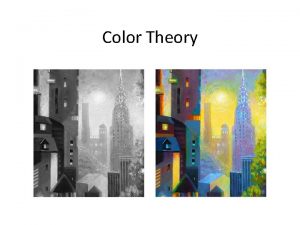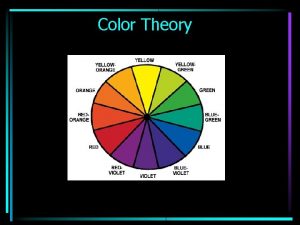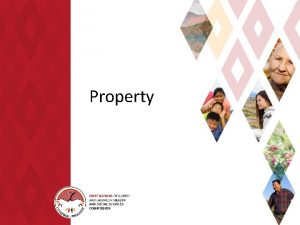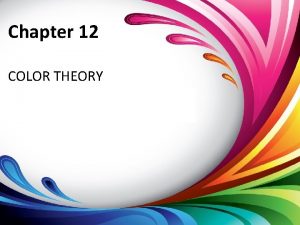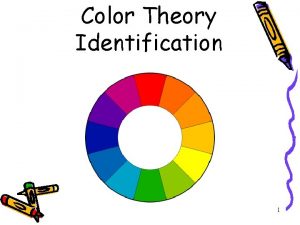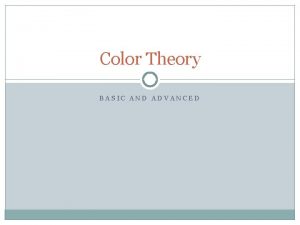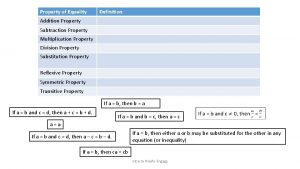Color Theory Color Definition Color the property possessed















- Slides: 15

Color Theory

Color: Definition Color: the property possessed by an object of producing different sensations on the eye as a result of the way the object reflects or emits light. AKA: When light shines on an object some colors bounce off the object and others are absorbed by it. Our eyes only see the colors that are bounced off or reflected.

Color Wheel The color wheel is a way to visualize and organize the entire color spectrum of light. The ends of the spectrum are bent around a circle to form a color wheel

Elements in the Color Wheel The Color Wheel can be described using three elements: HUE: Pure color SATURATION: How pale or strong a color is VALUE: Lightness or darkness

Hue • The technical name for color • Describes the position of a color on a classic color wheel • Used to name the color (Yellow, Orange, Red, etc. )

Saturation refers to how vivid and intense a color is

Value Lightness or Darkness of a color When referring to pigments, dark values with black added are called “shades” of the given hue name. Light values with white pigment added are called “tints” of the hue name

Traditional “Painter’s Color Wheel”/ Primary Colors In a traditional painter’s color wheel, the Primary Colors are Red, Yellow, and Blue. PRIMARY COLORS: Cannot be mixed. They are used for traditional pigment based art (Ex: painting)

Secondary Colors A color resulting from the mixing of two primary colors Green, Orange, and Violet/Purple

Tertiary/Intermediate Colors The result of mixing a Primary and a Secondary color together The intermediate colors are: Red. Orange, Yellow-Orange, Yellow. Green, Blue-Violet, and Red-Violet

Analogous Colors next to each other on the color wheel. One color tends to be dominant (primary or tertiary color).

Complementary Colors directly across from one another on the color wheel. They are highly contrasted. Mixed together they create ranges of brown Red and Green Blue and Orange Yellow and Purple

Split Complementary Colors The split-complementary color scheme is a variation of the complementary color scheme. In addition to the base color, it uses the two colors adjacent to its complement. This color scheme has the same strong visual contrast as the complementary color scheme, but has less tension.

Triadic Colors A scheme that uses colors that are evenly spaced around the color wheel.

Warm and Cool Colors 'Warm' colors, in the most general terms, are related to the yellow/red side of the color wheel chart. They attract attention and are generally perceived as energetic or exciting. ‘Cool' colors, on the other hand, sit on the blue/green side of the color wheel; they are generally perceived as soothing and calm.
 The descriptive property possessed by each entity set is
The descriptive property possessed by each entity set is Entity 210
Entity 210 Name somthing little kids hate
Name somthing little kids hate Possessed objects computer
Possessed objects computer Byron's notion that he possessed
Byron's notion that he possessed Angular motion biomechanics
Angular motion biomechanics Associative vs commutative
Associative vs commutative Doctrine of blending
Doctrine of blending Physical and chemical properties
Physical and chemical properties Hình ảnh bộ gõ cơ thể búng tay
Hình ảnh bộ gõ cơ thể búng tay Slidetodoc
Slidetodoc Bổ thể
Bổ thể Tỉ lệ cơ thể trẻ em
Tỉ lệ cơ thể trẻ em Gấu đi như thế nào
Gấu đi như thế nào Chụp phim tư thế worms-breton
Chụp phim tư thế worms-breton Hát lên người ơi
Hát lên người ơi


















